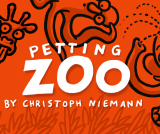From the Series
First Published in
Alan Fletcher will be remembered for both his clean, elegant, corporate logotypes and his whimsical, personal drawings and quirky musings on everything from colour and symmetry to rhetoric and wordplay.
Born to a British family in Kenya in 1931, Fletcher went to Britain as a five-year-old and despite sojourns in Italy, Spain and the United States eventually moved back to the UK with his Italian wife, Paola. It was here that he modernised the post-war visual landscape by creating sleek, contemporary identities for the Victoria & Albert Museum, Lloyd’s of London and the Institute of Directors.
Forming the company Fletcher/Forbes/Gill in 1962, with friend Colin Forbes and US graphic designer Bob Gill, was a watershed moment. The trio nurtured design excellence and helped to organise the first Design & Art Direction exhibition in 1963. Their book Graphic Design: A Visual Comparison celebrated a host of projects through the decades. Fletcher/Forbes/Gill also boasted clients such as Pirelli, Cunard, Penguin Books and Olivetti.
In 1965, the company transformed into Crosby/Fletcher/Forbes when Gill left and architect Theo Crosby came on board. The company handled multidisciplinary commissions, including a comprehensive design programme for news agency Reuters.
With Mervyn Kurlansky and Kenneth Grange, the company took on yet another identity, becoming the famed “Pentagram”. Clients at this time included Lloyd’s of London and Daimler Benz. Fletcher spent two decades at Pentagram, during which time the firm grew to include 11 partners, with offices opening in New York and San Francisco.
After some 20 years, Fletcher left Pentagram to set up studio at home, freelancing for, among others, Novartis and Phaidon (where he was consultant art director). His high design standards for Phaidon’s art, architecture and design books are legendary.
“Design is not a thing you do. It’s a way of life,” Alan Fletcher once famously said. Work, for him, was not a separate part of life but something integral to his creative output; just another way of expressing his vision. He wrote several books about graphic design and visual thinking and his seminal publication, The Art of Looking Sideways, has inspired a plethora of young designers, who worship him and his legacy.
From consummately elegant corporate logos to sketches, pictograms, flower paintings, fruit stickers, wine labels and collages of letters, full of urbane wit and delight, Fletcher remains one of the best-loved designers of his time. He won numerous awards and was elected to the Hall of Fame of the New York Art Directors’ Club in 1994. He was a senior fellow of the Royal College of Art in 1989 and became an honorary fellow of the London Institute in 2000.
Mike Dempsey, master of the Faculty of Royal Designers for Industry, and chairman and founding partner of CDT Design, shares some poignant memories.
I got to know Alan Fletcher rather late in my life. We were both members of the Faculty of Royal Designers for Industry and it was through this connection that I obtained an insight into the man whose work I had admired for as long as I can remember.
At faculty meetings, when those around him might be overly pontificating about a point, Alan would always cut right to the chase, exactly like the immediacy of his work.
To some, Alan could come across as a rather fearsome, almost grouchy individual, a view accentuated by his gravelly blunt voice. But at heart he was the most enthusiastic person you could possibly meet, with a generosity of spirit that would manifest itself in giving advice, donating time for a good cause or just commenting on a topic of mutual interest.
Some years ago I wrote a feature series for Design Week. It went under the title of Heroes. Alan was at the top of my list, but I delayed seeing him until I'd got a half dozen interviews under my belt. Alan, I felt, had been written about, photographed and interviewed so many times that I was inhibited about what I could bring to light about this particular hero. In the event, and because the meeting took place at his home, I was able to reveal something of the private man that perhaps hadn’t been captured before.
The following extract from the feature (Design Week 21 November 2002), which on re-reading I now find very touching, shows a loving grandfather at work. What becomes clear by the end of this little story is that Alan was the eternal child, fuelled by curiosity and delight.
"…While on holiday in Crete with his wife Paola, daughter Raffaella and his young grandson Tobias, he was given the task of amusing the youngster while the ladies went on a shopping trip. Fletcher, who admitted that he is not particularly good in these situations, sat looking at his grandson. The boy clearly had a lot of energy to burn up. Fletcher set his mind to work and instructed Tobias to rummage through the waste bin, cupboard and drawers to find any old boxes, corks, bottle tops and string, because granddad was going to make a him a zoo.
"Half an hour later the first few animals were born. Working rapidly with glue and scissors, Fletcher found himself engrossed in this process, so much so that he kept steering his young charge's sticky hands away from what was now becoming Fletcher's own array of animals. Feeling a little guilty, he had an idea. 'OK Tobias,' he said, 'I want you to think about this very carefully. You have to give names and sounds to all these animals.' This seemed to do the trick and during the course of the day an impressive collection of coloured creatures came to life. Tobias never actually got to keep them because Fletcher liked them so much."
A year later, those little animals were accepted for inclusion in the Royal Academy Summer Exhibition.
In an age dominated by instant celebrity, it was a real privilege to have known a true talent who was totally oblivious to his own stature. We'll all miss him greatly.
The Mike Dempsey tribute from Design Week was republished here with permission from the author.


















